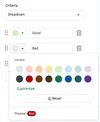3 ways to upgrade your Google Sheets habit tracker with smart chips

Change is hard, which is why breaking down goals into smaller, manageable tasks can be a great strategy. One way to hold yourself accountable when you’re trying to create new habits is by using a habit tracker, so you can visually measure whatever it is you want to work on; think of it like a personal inventory of the tasks or behaviors you want to get better at or simply do more often.
You can easily create a habit tracker in Google Sheets without having to know a single formula — it can be as simple as listing the dates of the month in the first column and the habits you want to track along the top row. Or you can use help me organize in Duet AI to generate a table instantly — simply write a short prompt about what you’re trying to achieve and Sheets will create the tracker for you. However you create your habit tracker, you can make it even more useful to you by using smart chips. Here are some ways that smart chips can help take your tracking to the next level.
1. Add dates and events
An easy way to automatically add dates and days of the week is by using the dates smart chip. Whether you use columns or rows for your time range, you can simply type “@date” into the first milestone cell and select a date. You could also type “@tuesday” and you’ll get options for upcoming Tuesdays.
Once you’ve added your start day, Sheets can automatically add dates and days of the week. Click the bottom right-hand corner of the start day cell until a small dot shows up. Then drag the cursor to your desired amount of cells; I’d suggest a month’s worth of dates to start. You can repeat this for the days of the week, too.
In Sheets you can also use the calendar events smart chip to add events directly from your Google Calendar. If one of the habits you want to track is reading or meditating and you’ve added reminders or dedicated time in your schedule to do these things, you can dedicate a row or column to these events by hitting “@” in the correct cell and scrolling until you see the event.

2. Add files
Let’s say you’re trying to journal more often — or trying to hit a certain word count in a novel you’re working on. You can add Workspace files to your habit tracker using smart chips — just hit “@” and scroll down to insert a specific Google Doc (or a Slide if presentations are more your thing) to the cell.

3. Add dropdowns and emoji
Some people find it helpful to track how they’re feeling day-to-day in their habit trackers — that way they might be able to see if there’s a connection between their mood and how many of their goals they checked off. (Oh, you always feel great on days you took a walk, stayed hydrated, and got enough sleep? Good to know!).
You can track your mood in a few ways. Option number one is hit “@” and scroll down to select “Dropdowns” — this allows you to create a dropdown menu that you can customize with your choice of options (i.e. Good, Bad, Okay — whatever you want it to say!).

Here’s how that works: When you hit the dropdowns smart chip, a menu will appear on the right-hand side of your Sheet. Type in the option names, adding as many as you want. You can change the color of the dropdown options by clicking on the circle next to the option title. Once you’ve created your dropdown menu, hover your cursor over the corner of the cell and drag to your desired area on the Sheet. Then you can assign a mood to any given day.

Another option is to use an emoji, also in smart chips: Hit “@” then scroll all the way down to “emoji” (or simply type @emoji). Maybe one day felt like a party hat and the next was more of a “shrug.” If so, don’t worry about it too much — I see lots of shooting star emoji in your habit tracker’s future.







